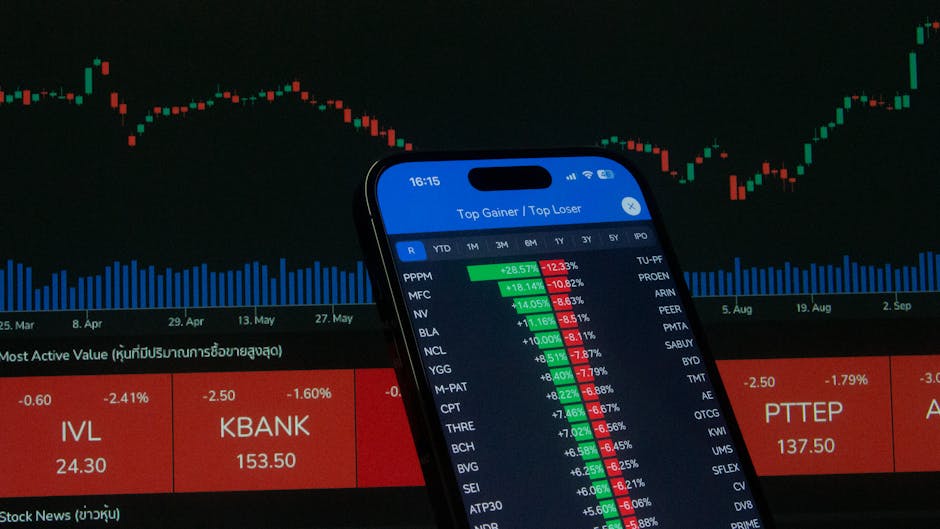Smart Investing in 2025: Stocks, Crypto, or AI-Driven Portfolios?
Navigate 2025’s smart investing landscape. Compare stocks, crypto & AI-driven portfolios with trends, risks, strategies & expert insights for optimal returns.
Navigating the Investment Crossroads of 2025
The investment landscape in 2025 stands at a fascinating and complex crossroads. Gone are the days of simple stock-and-bond allocations; today’s savvy investor must grapple with the explosive potential of artificial intelligence, the volatile allure of cryptocurrency, and the enduring, if sometimes staid, reliability of traditional equities. The question on every investor’s mind is no longer if they should invest, but where: Should you double down on blue-chip stocks, ride the next crypto wave, or entrust your capital to the algorithms powering AI-driven portfolios? This isn’t just about picking winners; it’s about understanding a fundamental shift in how wealth is created, managed, and protected in the digital age. The synthesis of artificial intelligence and blockchain platforms is emerging as a significant trend for 2025, particularly impacting trading, security, and automation . As we stand on the precipice of what many predict will be a transformative year, the smart investor is the one who can synthesize these disparate forces, weighing the risks and rewards of each asset class against their personal financial goals, risk tolerance, and time horizon. This comprehensive guide will dissect the 2025 outlook for stocks, crypto, and AI-driven portfolios, providing you with the data, trends, and strategic frameworks needed to make informed, confident decisions. Whether you’re a seasoned trader or a curious beginner, understanding these three pillars is no longer optional—it’s essential for building lasting wealth in the modern era.
The Enduring Powerhouse: Stocks in the AI Era (2025 Outlook)
Despite the meteoric rise of newer asset classes, traditional stocks remain the bedrock of most investment portfolios, and for good reason. In 2025, the stock market is not being overshadowed by AI and crypto; it is being fundamentally reshaped by them. The year 2025 has cemented AI’s role as an indispensable tool in stock market prediction, moving far beyond its early applications in rudimentary data analysis . This means that even “traditional” stock investing is now deeply intertwined with technological advancement.
Key Sectors and Trends Driving Stock Market Growth
The stock market’s performance in 2025 is heavily influenced by specific sectors riding the wave of innovation. AI dominated the best-performing S&P 500 stocks in 2024, with companies like Palantir and NVIDIA leading the charge to historic gains . This trend is expected to continue, if not accelerate. Beyond the obvious tech giants, look for growth in AI infrastructure investments, which are listed among the best investments for August 2025 . Companies providing the essential hardware, software, and cloud services that power the AI revolution are positioned for sustained growth. Furthermore, thematic investing in AI and geopolitical trends is gaining traction, offering investors a way to capitalize on broader macro shifts .
Other sectors showing promise include private equity and private credit, which offer alternative avenues for growth outside the public markets . Small-cap stocks, often more agile and able to capitalize on niche innovations, are also highlighted as a top investment for 2025 . The energy sector, which saw strong performance in 2024 alongside AI and airlines, may continue to be a factor depending on global geopolitical dynamics and the pace of the green transition .
Top AI Stocks to Watch: The New Market Leaders
Investing in stocks in 2025 increasingly means investing in AI, either directly or indirectly. Identifying the key players is crucial. Nvidia, Broadcom, Palantir Technologies, Advanced Micro Devices, Snowflake, and Super Micro Computer are frequently cited as some of the best AI stocks to watch . These companies are at the forefront of developing the chips, data analytics platforms, and computing power that fuel AI applications across every industry . For those seeking value or high-growth potential, stocks like Yiren Digital, Innodata, and Quantum Computing are also highlighted for August 2025 . Investing in these companies isn’t just a bet on their individual success; it’s a bet on the pervasive adoption of AI across the global economy, a market anticipated to surge from $11.3 billion in 2024 to $56.3 billion by 2030 .
Historical Performance: S&P 500 as a Benchmark
To understand the context for 2025, it’s vital to look at historical performance. The S&P 500, the benchmark index for the U.S. stock market, posted a 25% return in 2023, significantly above its long-term historical average of 11.5% . Between 1993 and 2024, the index delivered a positive return in 78% of those years . This historical resilience and consistent, albeit sometimes volatile, growth make it a critical anchor for any diversified portfolio. While assets like Bitcoin have delivered astronomical returns over shorter periods (a compound annual growth rate of 102.41% from 2011 to 2025), they come with significantly higher volatility, as evidenced by a standard deviation of 150.50% . The S&P 500 offers a more predictable, albeit lower, growth trajectory that has proven its worth over decades, making it an essential component for long-term wealth building and risk mitigation.
The Volatile Frontier: Cryptocurrency’s Evolution in 2025
Cryptocurrency, once the wild west of finance, is entering 2025 in a state of maturation, albeit one still characterized by significant volatility. The market is no longer defined solely by speculative mania but by regulatory shifts, institutional expansion, and powerful macroeconomic forces . The most significant trend for 2025 is the deepening synthesis of artificial intelligence and blockchain platforms, enhancing trading algorithms, security protocols, and smart contract automation . This convergence is creating new investment opportunities and use cases that extend far beyond simple price speculation.
2025 Crypto Market Trends: Beyond the Hype
The crypto landscape in 2025 is shaped by several key trends. First and foremost is regulatory clarity. Global cryptocurrency regulation is reaching a historic turning point, with once-gray areas gradually being defined by major jurisdictions . This tightening oversight, while potentially creating short-term friction, is ultimately seen as a positive for long-term institutional adoption . The approval of Bitcoin ETFs in 2024 was a watershed moment, and 2025 may see a wave of staked ETFs approved as regulatory bodies like the SEC adopt a more crypto-friendly approach .
Secondly, the intersection of AI and crypto is a major driver . AI is being used to analyze on-chain data, predict liquidity flows, and automate complex DeFi (Decentralized Finance) strategies, making the market more efficient and accessible . Thirdly, narrative-driven investing is becoming a sophisticated strategy, where investors allocate capital based on emerging technological or social themes within the crypto ecosystem, such as AI-powered blockchains or real-world asset tokenization . Finally, the role of stablecoins and DeFi continues to grow, offering yield-generating opportunities and financial services outside the traditional banking system .
Building a Diversified Crypto Portfolio: Strategies for 2025
Given the inherent volatility of crypto, diversification is not just recommended; it’s essential for survival. A smart 2025 crypto portfolio strategy involves more than just buying Bitcoin. Key principles include:
- Balancing Core and Satellite Holdings: Maintain a core position in established assets like Bitcoin and Ethereum, which offer relative stability within the crypto space, and allocate smaller portions to high-growth altcoins .
- Category Diversification: Invest across different categories such as Layer 1 blockchains, DeFi protocols, AI-integrated tokens, and metaverse projects to spread risk .
- Incorporating Stablecoins: Don’t ignore stablecoins. They provide a safe haven during market downturns and can be used to generate yield through lending or staking .
- Geographic and Narrative Exposure: Consider projects from different geographic regions and those aligned with compelling future narratives, like AI or sustainability .
- Leveraging AI Tools: Use AI-powered analytics platforms to identify trends, manage risk, and optimize asset allocation within your crypto portfolio .
Regulatory Outlook: Navigating the Global Landscape
The regulatory environment is perhaps the single biggest external factor influencing crypto in 2025. A lighter regulatory touch and specific, clear crypto legislation could be a major catalyst for adoption and sector growth . In the United States, a new administration promises a fresh approach to regulating digital and crypto assets . Globally, frameworks like MiCA (Markets in Crypto-Assets) in Europe are setting standards that others may follow . While increased regulation can cause short-term uncertainty, it is widely viewed as a necessary step to attract large-scale institutional capital, which requires clear rules and consumer protections. Investors must stay informed about regulatory developments in their jurisdictions, as these will directly impact which assets are available and how they can be traded.
The Algorithmic Advantage: AI-Driven Portfolios Explained
AI-driven portfolios represent the cutting edge of investment management, leveraging machine learning and vast datasets to make decisions that were once the sole domain of human analysts. In 2025, artificial intelligence is a core strategy driving smarter, faster, and more personalized portfolio management . These are not just simple robo-advisors of the past; they are sophisticated systems capable of real-time analysis, predictive modeling, and dynamic asset allocation.
How AI is Revolutionizing Investment Management
AI is transforming the entire investment lifecycle. It automates complex investment strategies, refines risk assessments with unprecedented granularity, and enhances asset allocation by identifying subtle correlations and opportunities invisible to the human eye . AI-powered tools can process news, social sentiment, economic indicators, and market data in milliseconds, allowing for rapid adjustments to market conditions. This is particularly valuable in volatile markets, where speed and data-driven objectivity are paramount. As agentic AI improves, even smaller, specialized models are being developed to enhance specific aspects of asset management .
Performance and Case Studies: Humans vs. Algorithms
The debate between human advisors and AI-driven platforms (robo-advisors) is ongoing. Research shows that clients working with human advisors achieve 59% of their financial goals, compared to 50% for those using robo-advisors, suggesting a current edge for human guidance in holistic planning . However, retail investors still tend to have higher trust in human advisers, though this gap is narrowing as technology proves its worth . Some studies demonstrate that robo-advisors can outperform conventional fund management, particularly in fixed income and money market strategies . The key advantages of AI platforms are lower fees, 24/7 accessibility, and objective, emotion-free decision-making . The future likely lies in a hybrid model, where AI handles data crunching and execution, while human advisors provide strategic oversight and behavioral coaching .
Risks and Rewards: Is AI Investing Right for You?
Investing via AI-driven portfolios offers significant potential rewards, including enhanced returns, reduced risk through better diversification, and improved efficiency . AI can make decision-making faster and enable the customization of investment portfolios to an individual’s precise risk profile . However, it is not without risks. The primary concerns include:
- Market Volatility and Bubbles: AI can amplify trends, potentially contributing to asset bubbles if many algorithms chase the same signals .
- Black Box Problem: The complexity of some AI models makes it difficult to understand why a decision was made, raising transparency issues.
- Data Bias and Errors: AI is only as good as the data it’s trained on. Biased or flawed data can lead to poor investment decisions .
- Cybersecurity Threats: AI systems are attractive targets for hackers, posing a risk to both data and assets .
- Over-Reliance: Investors may become overly dependent on algorithms, neglecting their own due diligence and understanding of their portfolio.
AI-driven investing is best suited for investors who value data-driven, low-cost, and hands-off management. It’s ideal for those with a long-term horizon who can tolerate the inherent risks of algorithmic trading. It is less suitable for those who require highly personalized, complex financial planning or who are uncomfortable with technology making critical financial decisions.
The Smart Investor’s Playbook: Comparing Stocks, Crypto, and AI Portfolios
Choosing between stocks, crypto, and AI-driven portfolios is not an either/or proposition for the savvy investor. The true “smart” strategy in 2025 involves understanding the unique risk-return profile of each and constructing a diversified portfolio that leverages their respective strengths. This section provides a head-to-head comparison to help you make informed allocation decisions.
Risk vs. Reward: A Detailed Breakdown
- Stocks (Traditional & AI-Related): Offer moderate to high risk, depending on the sector and company. Blue-chip stocks are generally lower risk, while growth stocks (like many AI companies) carry higher volatility. The reward potential is steady and historically proven, with the S&P 500 averaging 11.5% annually . AI stocks offer higher growth potential but come with the risk of technological disruption or market saturation.
- Cryptocurrency: Represents the highest risk category due to extreme volatility, regulatory uncertainty, and technological risks. However, it also offers the highest potential reward, as evidenced by Bitcoin’s historical compound annual growth rate exceeding 100% . The correlation between Bitcoin and the S&P 500 has fluctuated but peaked at 0.87 in 2024, indicating they are not entirely uncorrelated assets .
- AI-Driven Portfolios: The risk level depends on the underlying assets the AI is managing. An AI managing a portfolio of bonds will be lower risk than one trading volatile crypto. The primary risk is systemic—algorithmic errors, data bias, or a market environment that the AI hasn’t been trained for. The reward is the potential for optimized returns and superior risk management compared to a static human-managed portfolio .
Portfolio Allocation Strategies for 2025
There is no one-size-fits-all allocation. The optimal mix depends entirely on your age, risk tolerance, investment goals, and time horizon. However, here are some general frameworks for 2025:
- The Conservative Builder (e.g., nearing retirement): Focus on capital preservation. Allocate 70-80% to diversified stocks (including dividend payers and low-volatility ETFs), 10-15% to bonds, 5-10% to AI-driven portfolios for enhanced income generation, and 0-5% to crypto for minimal, high-risk exposure.
- The Balanced Growth Investor (e.g., mid-career): Aim for steady growth with moderate risk. Allocate 50-60% to a diversified stock portfolio (heavily weighted towards AI and tech growth sectors), 15-20% to AI-driven portfolios for dynamic asset allocation, 15-20% to bonds or bond alternatives, and 5-10% to a diversified crypto portfolio.
- The Aggressive Innovator (e.g., young investor with high risk tolerance): Focus on maximizing long-term growth. Allocate 40-50% to high-growth stocks (especially AI leaders), 20-30% to a diversified crypto portfolio, 20-30% to AI-driven portfolios (potentially with a higher risk mandate), and 0-10% to bonds for minimal stability.
The key is diversification within each category. Don’t put all your stock money in one AI company; diversify across sectors. Don’t put all your crypto in Bitcoin; diversify across categories. Don’t rely on one AI platform; understand its strategy and limitations.
Hybrid Approaches: Combining the Best of All Worlds
The most sophisticated 2025 strategies involve hybrid approaches that combine these asset classes synergistically. For example:
- Use an AI-driven portfolio as the core engine for managing your overall asset allocation across stocks, bonds, and even crypto, leveraging its data-processing power for rebalancing and risk management.
- Hold a core position in established stocks (like the S&P 500) for long-term stability and dividend income.
- Allocate a satellite portion to high-conviction AI stocks for targeted growth.
- Maintain a separate, actively managed crypto portfolio using AI-powered tools for research and risk assessment, treating it as a distinct, high-risk/high-reward sleeve.
This approach allows you to benefit from the efficiency of AI, the stability of traditional markets, and the explosive potential of crypto, all while managing overall portfolio risk through diversification and strategic allocation. The best strategy for 2025, according to some, is often to select a diversified group of long-term investments and stick with them, ignoring short-term noise .
Future-Proofing Your Wealth: Expert Predictions and Long-Term Strategies
Looking beyond the immediate horizon of 2025, the trends shaping the investment world point towards an increasingly integrated and technologically driven future. Experts predict that the lines between stocks, crypto, and AI will continue to blur, creating new paradigms for wealth creation. Understanding these long-term trajectories is crucial for future-proofing your portfolio.
Expert Predictions for 2025 and Beyond
Analysts and thought leaders are making bold predictions for the coming year and the decade ahead. In the crypto space, some predict Bitcoin will trade above $200,000, fueled by continued ETF inflows and halving cycle effects . Others forecast that Ethereum will outperform Bitcoin, driven by its robust ecosystem of DeFi and NFTs . The convergence of AI and crypto is expected to accelerate, leading to more intelligent, autonomous financial systems . In the stock market, AI is predicted to remain the dominant growth vector, with investment firms facing elevated risks and rewards as they integrate AI to grow revenue and streamline processes . The global AI platforms market is anticipated to surge to $56.3 billion by 2030, indicating massive long-term growth potential . Some even predict a return of the crypto bear market, highlighting the importance of preparedness for volatility .
Long-Term Investment Strategies for Sustainable Growth
Regardless of short-term predictions, the principles of long-term, sustainable wealth building remain constant:
- Embrace Diversification: This is the single most important strategy. Spread your investments across different asset classes (stocks, bonds, real estate, crypto), sectors, and geographies to mitigate risk. Diversification is key to managing risk and maximizing returns in crypto and is a fundamental principle for all investing .
- Invest for the Long Term: Avoid the temptation to time the market. Focus on long-term trends like AI adoption, demographic shifts, and technological innovation. The best investments are often those held for decades, allowing compound growth to work its magic.
- Continuous Learning and Adaptation: The investment landscape is evolving faster than ever. Commit to continuous learning. Stay informed about new technologies, regulatory changes, and economic trends. What works in 2025 may need adjustment in 2030.
- Prioritize Risk Management: Never invest more than you can afford to lose, especially in high-volatility assets like crypto. Use stop-loss orders, position sizing, and hedging strategies where appropriate. AI tools can significantly enhance risk management in portfolio construction .
- Automate and Systematize: Use technology to your advantage. Automate contributions to your investment accounts and use AI-driven tools for research and portfolio monitoring. This removes emotion and ensures discipline.
Preparing for Uncertainty: Building a Resilient Portfolio
The only certainty in investing is uncertainty. Geopolitical events, economic recessions, technological disruptions, and regulatory crackdowns can all impact your portfolio. Building resilience means preparing for these shocks:
- Maintain an Emergency Fund: Keep 3-6 months of living expenses in cash or cash equivalents. This prevents you from having to sell investments at a loss during a downturn.
- Stress-Test Your Portfolio: Regularly assess how your portfolio would perform under different adverse scenarios (e.g., a 30% market crash, a crypto winter, rising interest rates).
- Focus on Quality: In times of uncertainty, high-quality assets with strong fundamentals (for stocks) or robust use cases and communities (for crypto) tend to recover faster.
- Avoid Leverage: Using borrowed money to invest amplifies both gains and losses. In a volatile environment, leverage can lead to catastrophic losses.
- Review and Rebalance: At least once a year, review your portfolio and rebalance it back to your target asset allocation. This forces you to “sell high” and “buy low,” maintaining your desired risk level.
By focusing on these long-term, principle-based strategies, you can build a portfolio that not only thrives in the specific conditions of 2025 but is also resilient enough to weather whatever the future holds.
Frequently Asked Questions (FAQs)
Q1: Is it too late to invest in AI stocks or cryptocurrency in 2025?
A: It is not too late. While early adopters have reaped significant rewards, both AI and crypto are still in their early stages of mainstream adoption and technological development. The global AI platforms market is projected to grow from $11.3 billion in 2024 to $56.3 billion by 2030, indicating massive future growth potential . Similarly, cryptocurrency is evolving with increasing institutional involvement and regulatory clarity, suggesting a long runway ahead . The key is not timing the market perfectly but investing with a long-term perspective and a diversified strategy. Focus on companies and projects with strong fundamentals and real-world utility.
Q2: How much of my portfolio should be allocated to cryptocurrency?
A: There is no universal answer, as it depends entirely on your individual risk tolerance, investment goals, and time horizon. For most investors, cryptocurrency should be considered a high-risk, satellite allocation rather than a core holding. A common recommendation for aggressive investors is to allocate 5-10% of their total portfolio to crypto. More conservative investors might allocate 1-5%, or even 0%. It’s crucial to never invest more than you can afford to lose entirely. Building a diversified crypto portfolio, balancing core holdings like Bitcoin with exposure to various high-growth sectors, is a key strategy for managing this risk .
Q3: Can AI-driven portfolios really outperform human financial advisors?
A: The answer is nuanced. AI-driven portfolios, or robo-advisors, excel in areas like cost-efficiency, 24/7 operation, data processing, and removing emotional bias . Some studies show they can outperform conventional fund management in specific areas like fixed income . However, human advisors currently have an edge in achieving client financial goals (59% vs. 50%) and are still more trusted by many investors . Humans excel at understanding complex personal circumstances, providing behavioral coaching during market stress, and offering holistic financial planning that goes beyond just investments. The future likely belongs to a hybrid model, where AI handles the data and execution, and humans provide strategic oversight and personal guidance .
Q4: What are the biggest risks associated with AI-driven investing?
A: The primary risks include:
- Algorithmic Bias and Errors: AI is only as good as its training data. Flawed or biased data can lead to poor investment decisions .
- Lack of Transparency (“Black Box”): It can be difficult to understand why an AI made a specific trade, making it hard to assess risk or trust its decisions.
- Systemic Risk and Amplification: If many AI algorithms react to the same market signal, they can amplify volatility and contribute to flash crashes or asset bubbles .
- Cybersecurity Vulnerabilities: AI platforms are high-value targets for hackers, posing risks to both data privacy and asset security .
- Over-Reliance: Investors may become passive, neglecting their own due diligence and understanding of their portfolio’s strategy and risks.
Q5: How will regulation impact my investments in crypto and AI in 2025?
A: Regulation will have a profound impact, generally moving towards greater clarity and structure. For crypto, 2025 is seen as a pivotal year where global regulation is reaching a historic turning point . Tighter oversight may cause short-term volatility but is essential for attracting large-scale institutional investment and protecting consumers . In the U.S., a potential shift towards a more crypto-friendly SEC could lead to new product approvals like staked ETFs . For AI, regulation is also evolving, focusing on ethical use, bias mitigation, and cybersecurity in financial applications . While regulation may impose compliance costs, it ultimately legitimizes these asset classes and creates a more stable, trustworthy environment for long-term investment. Staying informed about regulatory developments in your region is crucial for any investor in these spaces.








